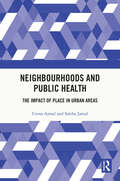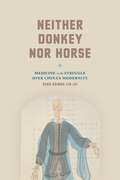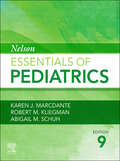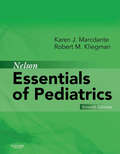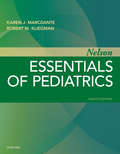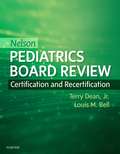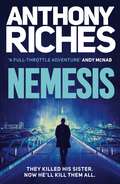- Table View
- List View
Neighbourhood Structure and Health Promotion
by Christiane Stock and Anne EllawayIt has long been theorized that people living in poor areas have more health problems than their more advantaged peers. More recently, science has been testing this hypothesis, concentrating on the impact of the built environment on well-being and its contribution to health inequities.Neighbourhood Structure and Health Promotion offers sociology-based theory and evidence-based findings so readers may better understand the effects of place on health choices, behaviour, and outcomes. This international volume analyzes the complex relationships among neighbourhood conditions and characteristics, people's perceptions of where they live, and their everyday health lives, from eating habits and activity levels to smoking, drinking, and drug use. Chapters introduce innovative methods for measuring and monitoring links between place and health in terms of risks and resources, and employing objective and subjective data. Prospects for engaging neighbourhoods in prevention efforts, particularly involving young people, and policy implications for the future of health promotion and inequity reduction are discussed as well. Included in the coverage:The spatiality of injustice: area effects on behaviour.Qualitative and quantitative methods for assessing neighbourhood health resources.The potential of GIS and GPS in the health sciences.Green spaces and health: possibilities for research and policy.School neighbourhoods and obesity prevention in youth.Connecting gender, social environment, and health.Neighbourhood Structure and Health Promotion advances the study of this increasingly critical topic, making it a valuable reference for researchers, practitioners, policy makers and advanced students in health, health promotion, social epidemiology, and urban planning.
Neighbourhoods and Public Health: The Impact of Place in Urban Areas
by Uzma Ajmal Saleha JamalThis book examines the concept of neighbourhood over space and time and understands how neighbourhoods can impact human health and well-being. It discusses the identification of neighbourhood boundaries, features of individual neighbourhoods, and the concept of neighbourhood in some major world as well as Indian cities. Based on extensive research, this study refers to both primary as well as secondary sources of data using various statistical and geo-spatial techniques. The first section of the book focuses on the concept of neighbourhood, concept of neighbourhood unit, methods used in the identification of neighbourhood boundaries and theories related to neighbourhood effects on health. The subsequent section of the book deals with a case study on neighbourhood effects on health in an Indian city. The case study is followed by a comparison of its results with other global studies. This book will be useful to the departments of Geography, Public Health, Sociology and Social Work. It will also be of use to professionals and practitioners like city planners, architects, NGOs, Environmentalists, and urban policy makers.
Neighbourhoods and Public Health: The Impact of Place in Urban Areas
by Uzma Ajmal Saleha JamalThis book examines the concept of neighbourhood over space and time and understands how neighbourhoods can impact human health and well-being. It discusses the identification of neighbourhood boundaries, features of individual neighbourhoods, and the concept of neighbourhood in some major world as well as Indian cities. Based on extensive research, this study refers to both primary as well as secondary sources of data using various statistical and geo-spatial techniques. The first section of the book focuses on the concept of neighbourhood, concept of neighbourhood unit, methods used in the identification of neighbourhood boundaries and theories related to neighbourhood effects on health. The subsequent section of the book deals with a case study on neighbourhood effects on health in an Indian city. The case study is followed by a comparison of its results with other global studies. This book will be useful to the departments of Geography, Public Health, Sociology and Social Work. It will also be of use to professionals and practitioners like city planners, architects, NGOs, Environmentalists, and urban policy makers.
Neisseria gonorrhoeae: Methods and Protocols (Methods in Molecular Biology #1997)
by Myron ChristodoulidesThis detailed book addresses the continual development and application of new methods and protocols to understand the biology of the pathogen Neisseria gonorrhoeae. Beginning with gonococcus biology and antimicrobial resistance, the volume continues with areas of study such as producing major gonococcal antigens to high purity, genetic transformation of gonococci and strategies for global RNA sequencing, evaluation of potential vaccine/drug targets and the assessment of hypothetical protein function, as well as a number of methods and protocols for studying the biological interactions of the gonococcus and the host. Written for the highly successful Methods in Molecular Biology series, chapters include introductions to their respective topics, lists of the necessary materials and reagents, step-by-step, readily reproducible laboratory protocols, and tips on troubleshooting and avoiding known pitfalls. Comprehensive and cutting-edge, Neisseria gonorrhoeae: Methods and Protocols provides researchers with a foundation for progress toward the eventual control of this disease and a significant reduction in global case numbers of gonorrhea.
Neisseria meningitidis: Advanced Methods and Protocols (Methods in Molecular Biology #799)
by Myron ChristodoulidesNeisseria meningitidis is a major causative agent, worldwide, of potentially life-threatening meningitis and septicaemia, which carry with them a high mortality rate and permanent physical and neurological issues for survivors. Neisseria meningitidis: Advanced Methods and Protocols offers a collection of methods and protocols that reflect the development and refinement of several new technologies applied to the meningococcus as presented by expert researchers. Several of the chapters in this book describe methods that rely on the collection of complete sets of biological data, for example, using the genome to generate transcriptomes, proteomes, and metabolomes. Written in the highly successful Methods in Molecular Biology™ series format, chapters include introductions to their respective topics, lists of the necessary materials and reagents, step-by-step, readily reproducible laboratory protocols, and tips on troubleshooting and avoiding known pitfalls. Authoritative and cutting-edge, Neisseria meningitidis: Advanced Methods and Protocols can be readily used to study other pathogens and diseases and should have broad appeal to clinical and non-clinical scientists alike; however, there is still much to learn about the meningococcus and its complex nature, which in turn continues to reveal crucial details about human biology as well.
Neisseria meningitidis: Methods and Protocols (Methods in Molecular Biology #1969)
by Kate L. Seib Ian R. PeakThis volume provides methods to analyze the meningococcus and its interactions with biologically relevant host cells and sites, to interrogate the population structure and biology of the meningococcus that defines its capacity to cause disease, and to aid in vaccine development and surveillance. Many of these methods are applicable to the close relative, Neisseria gonorrhoeae, and several of the methods described can also be used in investigating host-pathogen interactions for a range of other organisms. Written for the highly successful Methods in Molecular Biology series, chapters include introductions to their respective topics, lists of the necessary materials and reagents, step-by-step, readily reproducible protocols, and tips on troubleshooting and avoiding known pitfalls. Authoritative and practical, Neisseria meningitidis: Methods and Protocols will allow for the use of these methods by more laboratories and foster collaboration and consistency in investigations of this enigmatic and dangerous pathogen.
Neither Donkey nor Horse: Medicine in the Struggle over China's Modernity (Studies of the Weatherhead East Asian Institute)
by Sean Hsiang-lin LeiNeither Donkey nor Horse tells the story of how Chinese medicine was transformed from the antithesis of modernity in the early twentieth century into a potent symbol of and vehicle for China’s exploration of its own modernity half a century later. Instead of viewing this transition as derivative of the political history of modern China, Sean Hsiang-lin Lei argues that China’s medical history had a life of its own, one that at times directly influenced the ideological struggle over the meaning of China’s modernity and the Chinese state. Far from being a remnant of China’s premodern past, Chinese medicine in the twentieth century coevolved with Western medicine and the Nationalist state, undergoing a profound transformation—institutionally, epistemologically, and materially—that resulted in the creation of a modern Chinese medicine. This new medicine was derided as “neither donkey nor horse” because it necessarily betrayed both of the parental traditions and therefore was doomed to fail. Yet this hybrid medicine survived, through self-innovation and negotiation, thus challenging the conception of modernity that rejected the possibility of productive crossbreeding between the modern and the traditional. By exploring the production of modern Chinese medicine and China’s modernity in tandem, Lei offers both a political history of medicine and a medical history of the Chinese state.
Neither Donkey nor Horse: Medicine in the Struggle over China's Modernity (Studies of the Weatherhead East Asian Institute)
by Sean Hsiang-lin LeiNeither Donkey nor Horse tells the story of how Chinese medicine was transformed from the antithesis of modernity in the early twentieth century into a potent symbol of and vehicle for China’s exploration of its own modernity half a century later. Instead of viewing this transition as derivative of the political history of modern China, Sean Hsiang-lin Lei argues that China’s medical history had a life of its own, one that at times directly influenced the ideological struggle over the meaning of China’s modernity and the Chinese state. Far from being a remnant of China’s premodern past, Chinese medicine in the twentieth century coevolved with Western medicine and the Nationalist state, undergoing a profound transformation—institutionally, epistemologically, and materially—that resulted in the creation of a modern Chinese medicine. This new medicine was derided as “neither donkey nor horse” because it necessarily betrayed both of the parental traditions and therefore was doomed to fail. Yet this hybrid medicine survived, through self-innovation and negotiation, thus challenging the conception of modernity that rejected the possibility of productive crossbreeding between the modern and the traditional. By exploring the production of modern Chinese medicine and China’s modernity in tandem, Lei offers both a political history of medicine and a medical history of the Chinese state.
Neither Donkey nor Horse: Medicine in the Struggle over China's Modernity (Studies of the Weatherhead East Asian Institute)
by Sean Hsiang-lin LeiNeither Donkey nor Horse tells the story of how Chinese medicine was transformed from the antithesis of modernity in the early twentieth century into a potent symbol of and vehicle for China’s exploration of its own modernity half a century later. Instead of viewing this transition as derivative of the political history of modern China, Sean Hsiang-lin Lei argues that China’s medical history had a life of its own, one that at times directly influenced the ideological struggle over the meaning of China’s modernity and the Chinese state. Far from being a remnant of China’s premodern past, Chinese medicine in the twentieth century coevolved with Western medicine and the Nationalist state, undergoing a profound transformation—institutionally, epistemologically, and materially—that resulted in the creation of a modern Chinese medicine. This new medicine was derided as “neither donkey nor horse” because it necessarily betrayed both of the parental traditions and therefore was doomed to fail. Yet this hybrid medicine survived, through self-innovation and negotiation, thus challenging the conception of modernity that rejected the possibility of productive crossbreeding between the modern and the traditional. By exploring the production of modern Chinese medicine and China’s modernity in tandem, Lei offers both a political history of medicine and a medical history of the Chinese state.
Neither Donkey nor Horse: Medicine in the Struggle over China's Modernity (Studies of the Weatherhead East Asian Institute)
by Sean Hsiang-lin LeiNeither Donkey nor Horse tells the story of how Chinese medicine was transformed from the antithesis of modernity in the early twentieth century into a potent symbol of and vehicle for China’s exploration of its own modernity half a century later. Instead of viewing this transition as derivative of the political history of modern China, Sean Hsiang-lin Lei argues that China’s medical history had a life of its own, one that at times directly influenced the ideological struggle over the meaning of China’s modernity and the Chinese state. Far from being a remnant of China’s premodern past, Chinese medicine in the twentieth century coevolved with Western medicine and the Nationalist state, undergoing a profound transformation—institutionally, epistemologically, and materially—that resulted in the creation of a modern Chinese medicine. This new medicine was derided as “neither donkey nor horse” because it necessarily betrayed both of the parental traditions and therefore was doomed to fail. Yet this hybrid medicine survived, through self-innovation and negotiation, thus challenging the conception of modernity that rejected the possibility of productive crossbreeding between the modern and the traditional. By exploring the production of modern Chinese medicine and China’s modernity in tandem, Lei offers both a political history of medicine and a medical history of the Chinese state.
Neither Donkey nor Horse: Medicine in the Struggle over China's Modernity (Studies of the Weatherhead East Asian Institute)
by Sean Hsiang-lin LeiNeither Donkey nor Horse tells the story of how Chinese medicine was transformed from the antithesis of modernity in the early twentieth century into a potent symbol of and vehicle for China’s exploration of its own modernity half a century later. Instead of viewing this transition as derivative of the political history of modern China, Sean Hsiang-lin Lei argues that China’s medical history had a life of its own, one that at times directly influenced the ideological struggle over the meaning of China’s modernity and the Chinese state. Far from being a remnant of China’s premodern past, Chinese medicine in the twentieth century coevolved with Western medicine and the Nationalist state, undergoing a profound transformation—institutionally, epistemologically, and materially—that resulted in the creation of a modern Chinese medicine. This new medicine was derided as “neither donkey nor horse” because it necessarily betrayed both of the parental traditions and therefore was doomed to fail. Yet this hybrid medicine survived, through self-innovation and negotiation, thus challenging the conception of modernity that rejected the possibility of productive crossbreeding between the modern and the traditional. By exploring the production of modern Chinese medicine and China’s modernity in tandem, Lei offers both a political history of medicine and a medical history of the Chinese state.
Neither Donkey nor Horse: Medicine in the Struggle over China's Modernity (Studies of the Weatherhead East Asian Institute)
by Sean Hsiang-lin LeiNeither Donkey nor Horse tells the story of how Chinese medicine was transformed from the antithesis of modernity in the early twentieth century into a potent symbol of and vehicle for China’s exploration of its own modernity half a century later. Instead of viewing this transition as derivative of the political history of modern China, Sean Hsiang-lin Lei argues that China’s medical history had a life of its own, one that at times directly influenced the ideological struggle over the meaning of China’s modernity and the Chinese state. Far from being a remnant of China’s premodern past, Chinese medicine in the twentieth century coevolved with Western medicine and the Nationalist state, undergoing a profound transformation—institutionally, epistemologically, and materially—that resulted in the creation of a modern Chinese medicine. This new medicine was derided as “neither donkey nor horse” because it necessarily betrayed both of the parental traditions and therefore was doomed to fail. Yet this hybrid medicine survived, through self-innovation and negotiation, thus challenging the conception of modernity that rejected the possibility of productive crossbreeding between the modern and the traditional. By exploring the production of modern Chinese medicine and China’s modernity in tandem, Lei offers both a political history of medicine and a medical history of the Chinese state.
The Nell Dialogues: Conversation in Mortal Time
by Richard P. McQuellonNell M. came to her therapist with an unusual problem. She was disappointed that her metastatic breast cancer was not progressing as predicted. She had hoped breast cancer would lead to death, preventing her from witnessing her spouse's mental deterioration from Alzheimer's disease. This is how Nell's story began. As Nell became increasingly aware of her death on the near horizon, the therapy sessions with the author were recorded and transcribed. The Nell Dialogues: Conversation in Mortal Time consists of twelve of Nell's illness narratives that explore the challenges of managing the physical and emotional demands of cancer, relationship issues with family and health care professionals, and disturbing, anxiety provoking thoughts as well as the mourning that accompanies the end of life. These dialogues trace Nell's acceptance of, and struggle with, the practical obstacles to achieving a good death. They also offer a window on the world of patients and their caregivers facing a life-threatening illness together. A commentary by the author accompanies each dialogue, giving the reader insights on the therapist's thinking during the counselling sessions and offering context and lessons learned from them. Nell's vibrant voice is a beacon throughout the narratives, sometimes sad, yet always hopeful for a good death. Her ability to navigate the difficult territory of mortal time and dying informs the reader about how death might be approached with grace and dignity.
The Nell Dialogues: Conversation in Mortal Time
by Richard P. McQuellonNell M. came to her therapist with an unusual problem. She was disappointed that her metastatic breast cancer was not progressing as predicted. She had hoped breast cancer would lead to death, preventing her from witnessing her spouse's mental deterioration from Alzheimer's disease. This is how Nell's story began. As Nell became increasingly aware of her death on the near horizon, the therapy sessions with the author were recorded and transcribed. The Nell Dialogues: Conversation in Mortal Time consists of twelve of Nell's illness narratives that explore the challenges of managing the physical and emotional demands of cancer, relationship issues with family and health care professionals, and disturbing, anxiety provoking thoughts as well as the mourning that accompanies the end of life. These dialogues trace Nell's acceptance of, and struggle with, the practical obstacles to achieving a good death. They also offer a window on the world of patients and their caregivers facing a life-threatening illness together. A commentary by the author accompanies each dialogue, giving the reader insights on the therapist's thinking during the counselling sessions and offering context and lessons learned from them. Nell's vibrant voice is a beacon throughout the narratives, sometimes sad, yet always hopeful for a good death. Her ability to navigate the difficult territory of mortal time and dying informs the reader about how death might be approached with grace and dignity.
Nelson Essentials of Pediatrics,E-Book: Nelson Essentials of Pediatrics,E-Book
by Karen J. Marcdante Robert M. Kliegman Abigail M. Schuh, MD, MMHPEConcise, readable, and up to date, Nelson Essentials of Pediatrics, 9th Edition, provides the must-know information you need in pediatrics from the name you trust. A readable, full-color format; high-yield, targeted chapters; and thorough content updates ensure strong coverage of core knowledge as well as recent advances in the field. This focused resource is ideal for medical students, pediatric residents, PAs, and nurse practitioners in various educational and practice settings, including pediatric residencies, clerkships, and exams. Covers normal childhood growth and development, as well as the diagnosis, management, and prevention of common pediatric diseases and disorders. Contains new coverage of COVID-19, Multisystem Inflammatory Syndrome in Children (MIS-C), and Vaping-Induced Lung Injury. Includes Pearls for Practitioners at the end of each section, as well as updated immunization schedules and an expanded discussion of trauma-informed care. Features well written, high-yield coverage throughout, following COMSEP curriculum guidelines relevant to your pediatric clerkship or rotation. Uses a full-color format with images and numerous new tables throughout, so you can easily visualize complex information. Provides real-world insights from chapter authors who are also Clerkship Directors, helping you gain the knowledge and skills necessary to succeed both in caring for patients and in preparing for clerkship or in-service examinations.
Nelson Essentials of Pediatrics E-Book: With Student Consult Online Access (Nelson Essentials Of Pediatrics Ser.)
by Karen Marcdante Robert M. KliegmanThe resource of choice for pediatric residencies, clerkships, and exams, Nelson Essentials of Pediatrics continues to provide a focused overview of the core knowledge in pediatrics. Succinct, targeted coverage of normal childhood growth and development, as well as the diagnosis, management, and prevention of common pediatric diseases and disorders, make this an ideal medical reference book for students, pediatric residents, nurse practitioners, and physician assistants.Consult this title on your favorite e-reader, conduct rapid searches, and adjust font sizes for optimal readability. Get an effective overview of pediatrics with help from concise text, a full-color design, high-yield tables, and numerous images.Take advantage of a wealth of images that capture the clinical manifestations and findings associated with Kawasaki disease, lupus, lymphoma, stroke, and many other disorders seen in children.Efficiently review essential, concise pediatric content with this popular extension of the Nelson Textbook of Pediatrics (ISBN: 978-1-4377-0755-7).Focus on the core knowledge needed for your pediatric clerkship or rotation with coverage that follows the COMSEP curriculum guidelines.Easily visualize complex aspects with a full-color layout and images, as well as numerous tables throughout the text.
Nelson Essentials of Pediatrics E-Book: With Student Consult Online Access (Nelson Essentials Of Pediatrics Ser.)
by Karen Marcdante Robert M. KliegmanPart of the highly regarded Nelson family of pediatric references, Nelson Essentials of Pediatrics, 8th Edition, is a concise, focused resource for medical students, pediatric residents, PAs, and nurse practitioners. Ideal for pediatric residencies, clerkships, and exams, this 8th Edition offers a readable, full-color format; high-yield, targeted chapters; and new features that make it even more user-friendly for today’s in-training professionals or practitioners.Focuses on the core knowledge you need to know, while also providing complete coverage of recent advances in pediatrics. Coverage includes normal childhood growth and development, as well as the diagnosis, management, and prevention of common pediatric diseases and disorders.Includes new Pearls for Practitioners bullets at the end of each section, providing key clinical points and treatment information.Features well written, high-yield coverage throughout, following COMSEP curriculum guidelines relevant to your pediatric clerkship or rotation.Uses a full-color format with images and numerous new tables throughout, so you can easily visualize complex information.Provides real-world insights from chapter authors who are also Clerkship Directors, helping you gain the knowledge and skills necessary to succeed both in caring for patients and in preparing for clerkship or in-service examinations
Nelson Pediatric Symptom-Based Diagnosis E-Book
by Robert M. Kliegman Patricia S Lye Brett J. Bordini Heather Toth Donald BaselNelson Pediatric Symptom-Based Diagnosis uses a unique, step-by-step, symptom-based approach to differential diagnosis of diseases and disorders in children and adolescents. Conveniently linked to the world’s best-selling pediatric reference, Nelson Textbook of Pediatrics, 20th Edition, it focuses on the symptoms you’re likely to see in general practice, as well as uncommon disorders. You’ll find clear guidance on exactly what to consider and how to proceed when faced with a host of common symptoms such as cough, fever, headache, chest pain, gait disturbances, and many more.Features a practical, symptom-based approach that enables you to form an accurate diagnosis. Uses the same consistent, step-by-step presentation in every chapter: History, Physical Examination, Diagnosis (including laboratory tests), Imaging, Diagnosis, and Treatment. Covers new approaches to diagnostic imaging and genetic testing, new diagnostic guidelines, BRUE (brief resolved unexplained event), stroke in children, behavior disorders, syncope, recurrent fever syndromes, and much more. Includes full-color illustrations, algorithms, tables, and "red flags" to aid differential diagnosis. Serves as an ideal companion to Nelson Textbook of Pediatrics, 20th Edition.
Nelson Pediatrics Board Review E-Book: Certification and Recertification
by Terry Dean, Jr. Louis M BellReview and retain the information you need for success on the boards with Nelson Pediatrics Board Review: Certification and Recertification. This highly practical review tool follows the American Board of Pediatrics (ABP) general pediatrics content outline, with topics weighted to correlate with the exam. Must-know information is presented in a way that’s easy to study and remember, and is backed by the Nelson family of references that you know and trust for current, authoritative information in your field.Equips residents and physicians with an efficient, comprehensive system for study, designed specifically to help you perform at your best on the board exam.Presents information in a bulleted, high-yield format, with topics matching ABP content guidelines.Provides a real-world balance of necessary fundamental information and cutting-edge advances – all carefully written and reviewed by editors and contributors from the world renowned Children’s Hospital of Philadelphia (CHOP).Features over 600 board-style questions with full, discursive answers online.Includes reader-friendly features that promote testing success: tables that show differences between diagnoses, genetic disorders grouped by key features in phenotypic presentation rather than in alphabetical order, and more – all designed to help you recall key information when taking exams. Provides online links to the Nelson Textbook of Pediatrics that offer a complete presentation of the content, including evidence-based treatment and management.
Nelson Textbook of Pediatrics E-Book: Expert Consult Premium Edition - Enhanced Online Features And Print
by Robert M. Kliegman Bonita F. Stanton Joseph St. Geme Nina F Schor Richard E. BehrmanNelson Textbook of Pediatrics has been the world’s most trusted pediatrics resource for nearly 75 years. Drs. Robert Kliegman, Bonita Stanton, Richard Behrman, and two new editors—Drs. Joseph St. Geme and Nina Schor—continue to provide the most authoritative coverage of the best approaches to care. This streamlined new edition covers the latest on genetics, neurology, infectious disease, melamine poisoning, sexual identity and adolescent homosexuality, psychosis associated with epilepsy, and more.Understand the principles of therapy and which drugs and dosages to prescribe for every disease. Locate key content easily and identify clinical conditions quickly thanks to a full-color design and full-color photographs. Stay current on recent developments and hot topics such as melamine poisoning, long-term mechanical ventilation in the acutely ill child, sexual identity and adolescent homosexuality, age-specific behavior disturbances, and psychosis associated with epilepsy. Tap into substantially enhanced content with world-leading clinical and research expertise from two new editors—Joseph St. Geme, III, MD and Nina Schor, MD—who contribute on the key subspecialties, including pediatric infectious disease and pediatric neurology. Manage the transition to adult healthcare for children with chronic diseases through discussions of the overall health needs of patients with congenital heart defects, diabetes, and cystic fibrosis. Recognize, diagnose, and manage genetic conditions more effectively using an expanded section that covers these diseases, disorders, and syndromes extensively. Find information on chronic and common dermatologic problems more easily with a more intuitive reorganization of the section.
Nematodes as Model Organisms
by Sigal Braun Miyara Fernando Calahorro Raquel Campos-Herrera Ioannis Eleftherianos James Dillon Katarzyna Dudkiewicz Birgit Gansfort Heidi Goodrich-Blair Alex S. Grossman Selcuk Hazir Jennifer K. Heppert Ivan Hiltpold Lindy Holden-Dye Sebastian Höss Anil Kumar Emilie Lefoulon Edwin E. Lewis James W. Lightfoot Terra J. Mauer Vincent O’Connor Ratnasri Pothula Elizabeth M. Ransone Sara Sánchez Moreno Glen Stevens Ralf J. Sommer S. Patricia Stock Ghada Tafesh-Edwards Heidi A. Tissenbaum Professor Walter Traunspurger Robert J Walker Dayong WangNematodes are small multicellular organisms that have been used as biological models since the 1960s. For example, Caenorhabditis elegans is a free-living nematode worm, about 1mm in length, that lives in temperate soil environments. It is made up of about 1000 cells, and has a short life cycle of only two weeks. It was the first multicellular organism to have its whole genome sequenced. The book summarizes the importance of nematodes as model organisms in the fields of genetics, developmental biology, neurobiology, pharmacology, nutrition, ecology and parasitology. Of interest to a broad audience across a wide spectrum of disciplines, this book is useful for biologists working on comparative studies to investigate biological processes across organisms; medical scientists and pharmacologists for exploration of drugs and medicine (including the use of genome editing to eliminate diseases); ecologists considering nematodes as indicators for environment changes; and parasitologists for host-parasite interactions. Many other researchers can use this book as a benchmark for the broad implications of nematology research on other aspects of science.
Nematology in South Africa: From Its Early Beginnings To Facing New Challenges
by Hendrika Fourie Vaughan W. Spaull Robin K. Jones Mieke S. Daneel Dirk De WaeleThis unique book contains not only a comprehensive up-to-date summary of the achievements made in all areas of Nematology in South Africa over more than half a century, but it also combines this rather technical part with an insiders narrative of how Nematology started and developed. It also demonstrates how the South African community of nematologists gradually adapted to major changes in agriculture. These were due to a major political shift followed by socio-economic changes and this in an often challenging natural environment. At the same time this book is conceived as a useful source for young scientists to provide them with practical knowledge and critical insight in the field of Nematology. The information given is based primarily on research conducted by nematologists in South Africa. Most of this research was aimed at finding workable solutions for nematological problems confronted by both large-scale commercial producers and smallholding farmers. During a period when funding for scientific research is becoming increasingly scarce, the future demand and quest for practical solutions by applied research will only increase.
Nemesis (The Protector)
by Anthony RichesMickey Bale, a Met close protection officer, wants revenge on the mafia family who killed his sister. First in The Protector, a gripping British thriller series from Anthony Riches. 'Nemesis is a full-throttle adventure' ANDY McNAB'Fast-moving... The Bill meets Jack Reacher' THE TIMES Thriller of the MonthThey killed his sister. Now he'll kill them all. Mickey Bale is an elite close protection officer. That's why the Met police has given him the toughest job of all: guarding the Minister of Defence at a moment when Chinese-British relations have hit a deadly boiling point.And when Mickey's life isn't on the line for his work, he's taking his chances waging war on a powerful London gang family. Their dealer supplied a lethal ecstasy pill to his sister, and Mickey is determined to take them down, one at a time.But will he get away with it – or will his colleagues in the force realise that the man on an underworld killing spree is one of their own?'Nemesis is a full-throttle adventure that twists and turns from the corridors of power to London's gangland underbelly, propelled by a hero with a thirst for vengeance and the skillset to execute it' Andy McNab'Nemesis kicks like a 12-bore shotgun... A British thriller to rival Reacher' Giles Kristian'Mickey Bale is a Jack Reacher for a harder, faster, more assured millennium. Nemesis is the kind of book for which the word 'compelling' was coined' Manda Scott'Meet Mickey Bale – London's John Wick. A rocket-propelled grenade of a book, shot through with gallows humour. Guy Ritchie meets Lee Child' Robyn Young'This may be Riches' first contemporary-set novel but he throws his protagonist into a gladiatorial climax worthy of Ancient Rome' Shots
Neo-Victorian Freakery: The Cultural Afterlife of the Victorian Freak Show
by Helen DaviesNeo-Victorian Freakery explores the way in which contemporary fiction, film, and television has revisited the lives of nineteenth-century freak show performers. It locates the neo-Victorian freak show as a crucial forum for debating the politics of disability, gender, sexuality and race within the genre more broadly.
Neo-Victorian Freakery: The Cultural Afterlife of the Victorian Freak Show (PDF)
by Helen DaviesNeo-Victorian Freakery explores the way in which contemporary fiction, film, and television has revisited the lives of nineteenth-century freak show performers. It locates the neo-Victorian freak show as a crucial forum for debating the politics of disability, gender, sexuality and race within the genre more broadly.

